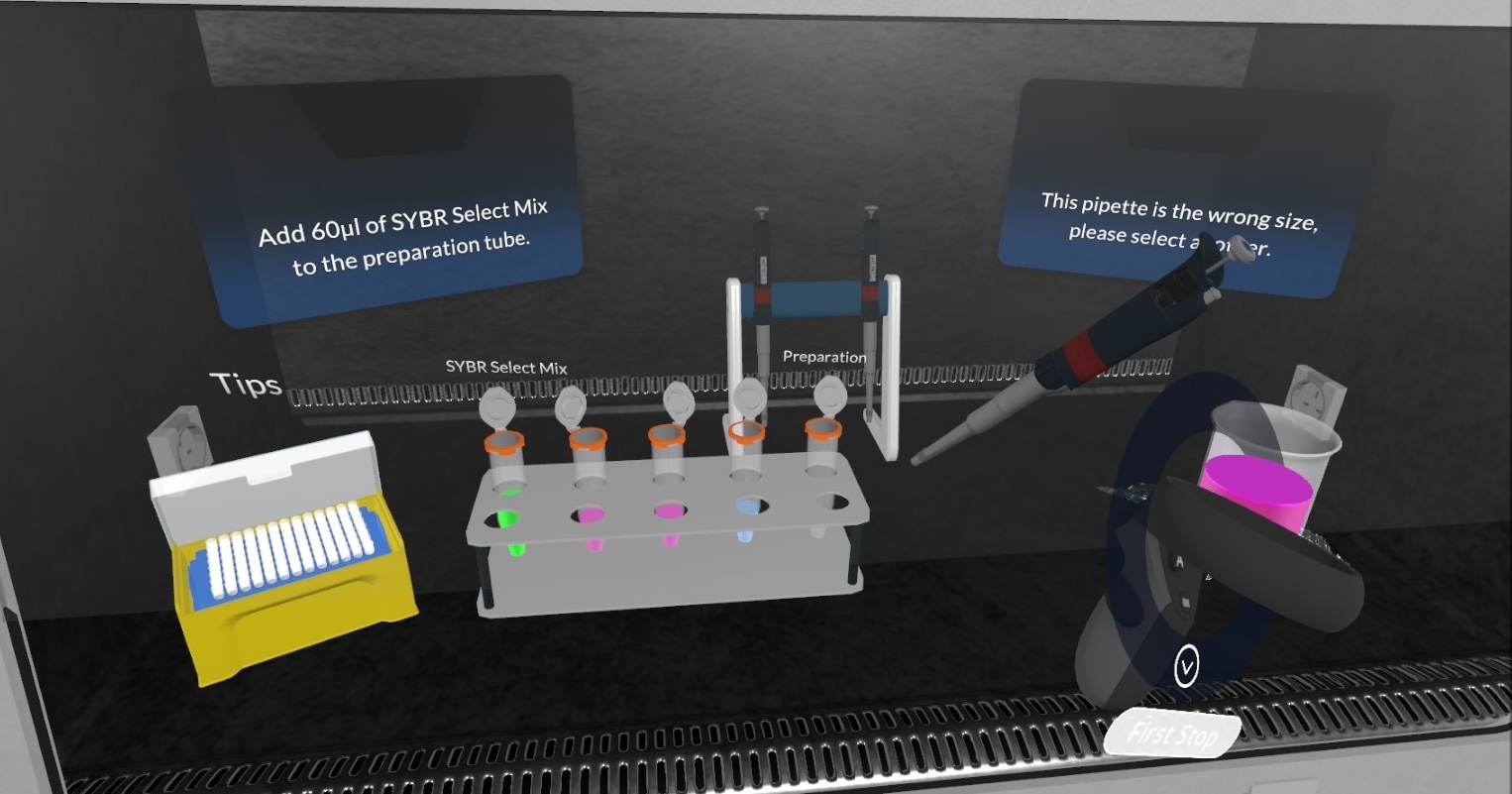
Improving student engagement in the virtual world of disease diagnostics
A key laboratory for undergraduates in Life Sciences at the UofG is the Junior Honors Molecular Methods (MM) course, that allows students to gain practical skills in molecular biology that are essential for future employability. As part of the online delivery of the MM course during the COVID-19 pandemic, a new bespoke Virtual Reality (VR) app was utilised. The VR app was embedded into a ‘Disease Diagnostics’ lesson within the MM course, with the user experiencing the processes involved in diagnosing a viral disease in an immersive research lab environment. This VR app was designed by a team of UofG staff and the VR-design company, Edify in 2017, utilised during the COVID-19 pandemic remotely by-proxy, and since 2022 been delivered on campus.
During the VR lesson, students experienced entering a VR disease diagnostics research laboratory that was modelled on a laboratory at the UofG, initially putting on a lab coat and washing their hands (Figure 1). For many of our junior honours students this will be the first time they have explored a research lab environment. Moving into the lab by teleportation, the user arrives at a sterile microbiological safety cabinet in order to set up an experiment using automated pipettes. Various instructions pop up along the way, allowing flow from one set of tasks to the next. The students visualised how to set up an experiment that is used to quantify the concentration of viral components within human blood samples. The students are then teleported to a machine that processes the samples and generates data which is visualised within the VR environment. This data is also available for analysis during an in-person session.
During the COVID-19 pandemic, a lecturer who coordinates and teaches on the MM course donned a VR headset at home and delivered the lesson to undergraduate biology students from multiple degree disciplines. Approximately 600 students a year take the MM course across the academic year and are split into small teaching groups depending on their subject specialism. A lecturer with extensive knowledge and research experience facilitated the session, answering student questions about various topics relating to the lesson in real time using the Zoom chat function.
The VR lesson is now delivered on campus, in a multi-user VR space, allowing 15 students to wear a headset at one time. Students work through the VR lesson either as an individual, or as a pair (with one student in VR and the other observing and supporting). The lesson acts as a pre-lab before the students go into an intensive weeklong lab, putting the molecular skills they learned in VR into use.
Student feedback has been predominantly positive for both by-proxy and in-person teaching. It has indicated that after using the VR app in both settings, not only did they feel more confident in their understanding of the key concepts, but that the experience had increased their confidence in their ability to carry out these experiments in a real-world setting. During the pandemic, the VR experience allowed students to consolidate their learning from the online course material, as well as giving them a shared opportunity to get as close as possible to being within a real-world laboratory environment whilst working remotely.
Now back on campus, a major draw of using VR to teach practical skills is maximise on lab time when lab space is at a premium whilst minimising unnecessary plastic lab waste. In a VR lab, no matter the size of the class, users can consistently repeat the experience in a controlled environment with no real-world consequences using resources that do not break or wear out. It also opens up new possibilities for working with equipment or reagents that are beyond reach within traditional teaching labs. Furthermore, trouble shooting is a vital part of learning precise experimental procedures. If a student makes a mistake in a simulated lab, they are given a warning and prevented from progressing until they have corrected the mistake at the time they make it. In the real world, it may be a substantial period of time before they receive their results and the students have to mentally retrace their steps to identify the point of error. Providing effective and timely feedback should be a key feature during the development process of future VR designs to supporting students and capitalise on the experience. VR applications, like the Disease Diagnostic VR app, hold great potential to addressing important skills gaps in our current training and will enhance the workforce readiness of our graduates.

